当前位置:网站首页>Future usage details
Future usage details
2022-04-23 17:36:00 【Flechazo`】
Future Usage details
Preface
Why does it appear Future Mechanism
Two common ways to create threads . One is direct inheritance Thread, The other is to realize Runnable Interface .
One drawback of both approaches is that : Unable to get execution result after task execution .
from Java 1.5 Start , Provided. Callable and Future, Through them, you can get the task execution result after the task execution .
Future The core idea of the pattern is to enable the main thread to use the time that it needs to wait synchronously to do other things .
Because the execution results can be obtained asynchronously , So you don't have to wait synchronously to get the execution result .
Future Usage details
It's easy to use
System.out.println(" main start ");
FutureTask<Integer> integerFutureTask = new FutureTask<>(new TestA());
new Thread(integerFutureTask).start();
System.out.println(" integerFutureTask ...");
Integer integer = integerFutureTask.get();
System.out.println(integer);
System.out.println(" main end ");
class TestA implements Callable<Integer>{
@Override
public Integer call() throws Exception {
System.out.println(" call start ");
Thread.sleep(10000);
System.out.println(" call end ");
return 1;
}
}
get It will always block access
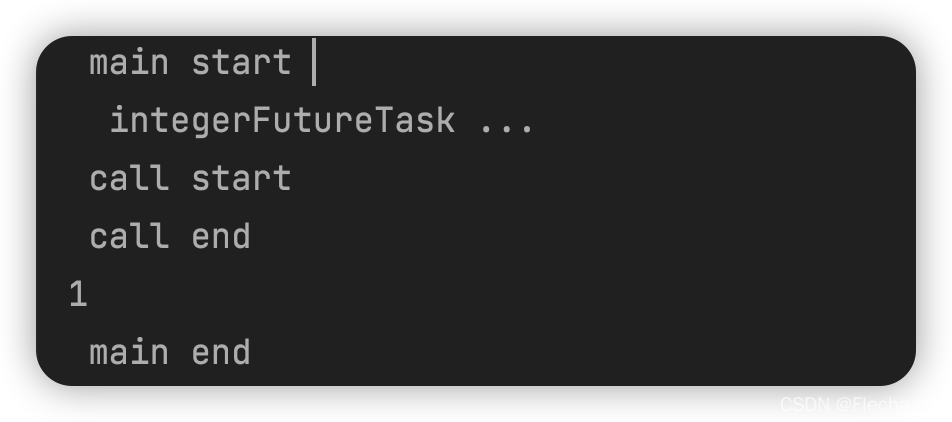
Of course, you can also set the timeout
public V get(long timeout, TimeUnit unit)
Future Simple principle
It's simple to use , Let's study the specific principle
We all know Thread Can only run Runable Interface
How does the return value return ?
FutureTask<Integer> integerFutureTask = new FutureTask<>(new TestA()); In this line of code, you can see FutureTask Realized RunnableFuture Interface

Continue to look at RunnableFuture The interface inherits our Runnable Interface And inherited a Future Interface

Future Interface
Defines some methods that return values
public interface Future<V> {
// Cancel
boolean cancel(boolean mayInterruptIfRunning);
// Whether to cancel
boolean isCancelled();
// Whether to carry out
boolean isDone();
// obtain
V get() throws InterruptedException, ExecutionException;
// Timeout to get
V get(long timeout, TimeUnit unit)
throws InterruptedException, ExecutionException, TimeoutException;
}
The principle and process are as follows
First step

Initialization task , Set thread state
We can see several states of the thread and some states from start to end
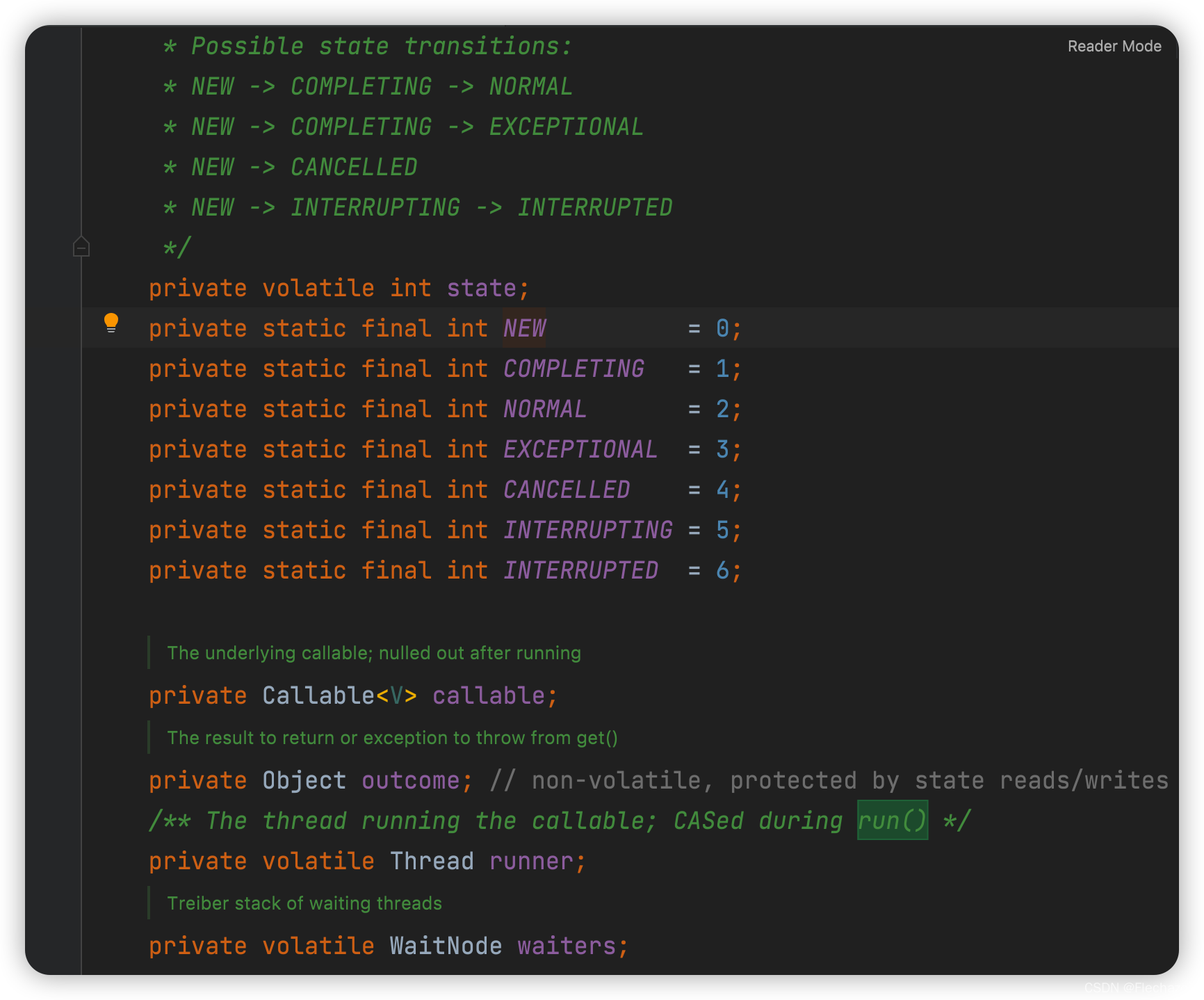
outcome Is the return value of the output
runner Indicates the running thread
waiters Indicates the waiting thread
The second step
run Method run
public void run() {
// Determine whether it is running
if (state != NEW ||
!UNSAFE.compareAndSwapObject(this, runnerOffset,
null, Thread.currentThread()))
return;
try {
//
Callable<V> c = callable;
if (c != null && state == NEW) {
V result;
boolean ran;
try {
// actual The bottom layer is still running call Interface
result = c.call();
// Running state
ran = true;
} catch (Throwable ex) {
result = null;
ran = false;
// Handling exceptions
setException(ex);
}
if (ran)
//c.call() At the end of the run , Set result
set(result);
}
} finally {
// runner must be non-null until state is settled to
// prevent concurrent calls to run()
runner = null;
// state must be re-read after nulling runner to prevent
// leaked interrupts
int s = state;
// If the thread is interrupted
if (s >= INTERRUPTING)
handlePossibleCancellationInterrupt(s);
}
}
The setting result sets the thread state to , Also set the value outcome

Third parts
get To get the results

You can see that when the state is not greater than or equal to COMPLETING It will block
private int awaitDone(boolean timed, long nanos)
throws InterruptedException {
final long deadline = timed ? System.nanoTime() + nanos : 0L;
WaitNode q = null;
boolean queued = false;
for (;;) {
// If the thread is interrupted
if (Thread.interrupted()) {
// Waiting to be removed from the queue
removeWaiter(q);
throw new InterruptedException();
}
int s = state;
// Execution completed
if (s > COMPLETING) {
if (q != null)
q.thread = null;
return s;
}
else if (s == COMPLETING) // cannot time out yet
// hand over cpu Executive power Re competition
Thread.yield();
else if (q == null)
q = new WaitNode();
else if (!queued)
// Next thread Wake up the
queued = UNSAFE.compareAndSwapObject(this, waitersOffset,
q.next = waiters, q);
else if (timed) {
// Overtime
nanos = deadline - System.nanoTime();
if (nanos <= 0L) {
removeWaiter(q);
return state;
}
LockSupport.parkNanos(this, nanos);
}
else
LockSupport.park(this);
}
}
Return value Strong transition type
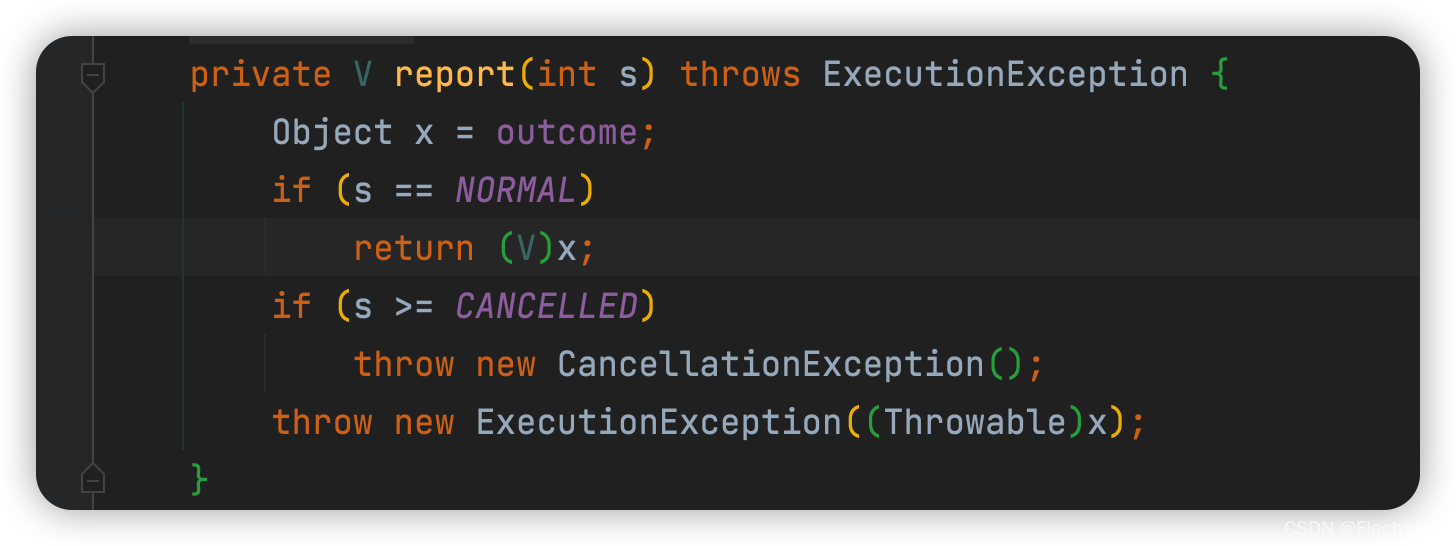
Thread pool return principle
Submit a return task with parameters

Submission code

Also to FutureTask To carry out

Custom return task value
You can refer to this to implement your own submission
Get data interface
public interface Future<T> {
T get() throws InterruptedException;
}
Do things interface
public interface FutureTask<T> {
T call();
}
Submit processing tasks asynchronously
public class FutureTaskService {
/** * Submit processing tasks asynchronously * @param futureTask * @param <T> * @return */
public <T> Future<T> submit(final FutureTask<T> futureTask){
// Asynchronous return
AysFutureTask<T> aysFutureTask = new AysFutureTask();
// Threads handle tasks
new Thread(()->{
// Perform tasks
T call = futureTask.call();
// Finish the task Notification return
aysFutureTask.done(call);
}).start();
// Asynchronous return
return aysFutureTask;
}
}
test
public class MainTest {
public static void main(String[] args) throws InterruptedException {
FutureTaskService futureTaskService = new FutureTaskService();
Future<String> submit = futureTaskService.submit(() -> {
// Submit tasks
return doThing();
});
System.out.println(" -------- return ------- ");
System.out.println(" --------- Do something else ----- ");
System.out.println(" --------- do other ----- ");
// obtain The task just submitted
System.out.println(submit.get());
}
/** * Simulate database reading and writing perhaps Network request * @return */
private static String doThing(){
try {
Thread.sleep(5_000);
} catch (InterruptedException e) {
e.printStackTrace();
}
return " Do things ...";
}
}
test result

You can see the task we submitted first , Get the results after handling other things in front , During this period, the task is being carried out , Perform multiple tasks at the same time , Blocking the results at the last moment .
Last
FutureTask yes Future The concrete realization of .
FutureTask Realized RunnableFuture Interface .RunnableFuture The interface also inherits Future and Runnable Interface .
Thread You can submit FutureTask It's actually execution call Method
And then use cas Compare thread status and wait for results
Future Inheritance graph
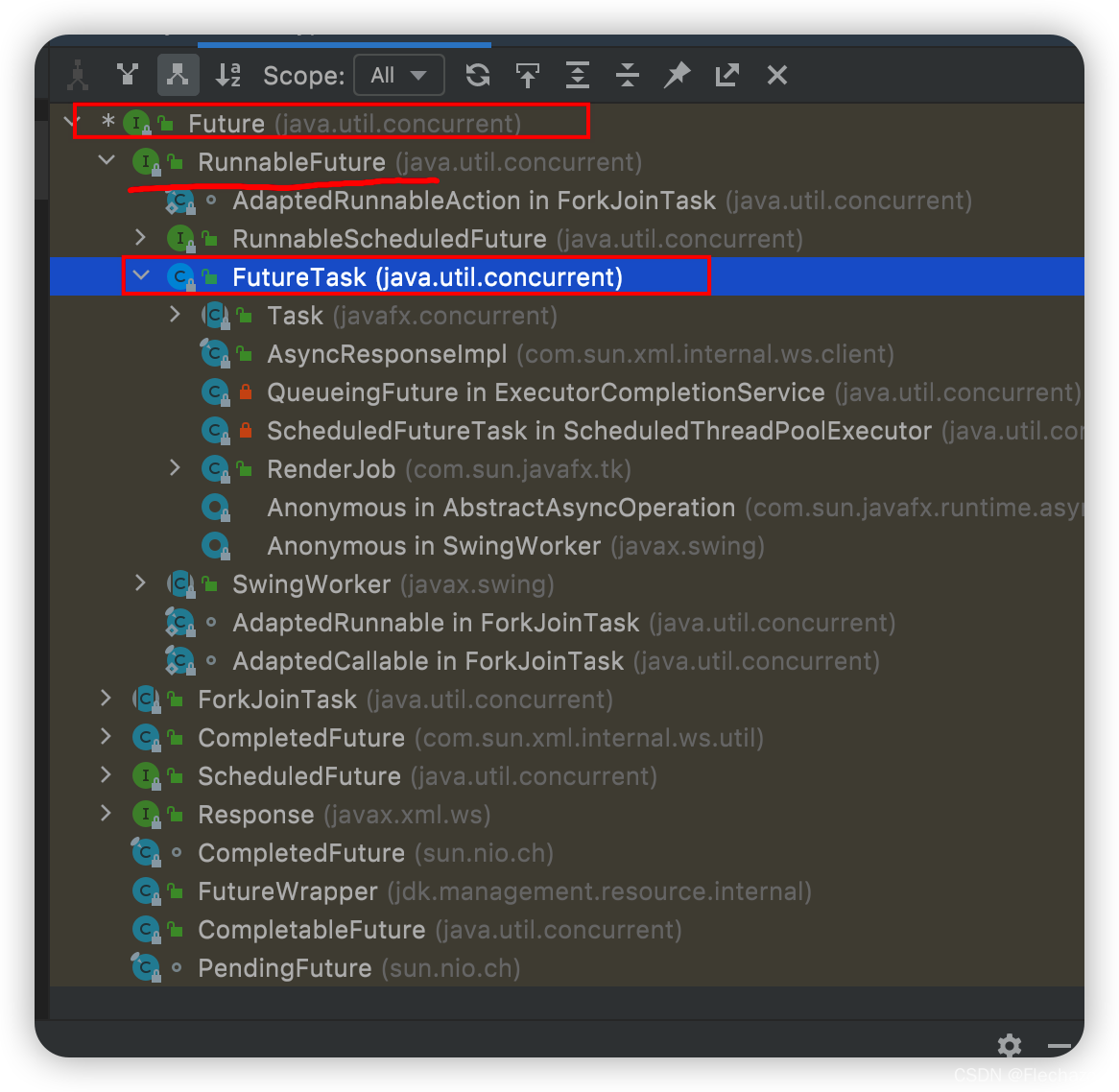
Of course Future There are other extended uses , Such as CompletableFuture etc.
版权声明
本文为[Flechazo`]所创,转载请带上原文链接,感谢
https://yzsam.com/2022/04/202204231727205353.html
边栏推荐
- [ES6] promise related (event loop, macro / micro task, promise, await / await)
- ASP. Net core dependency injection service life cycle
- ClickHouse-表引擎
- C listens for WMI events
- [logical fallacy in life] Scarecrow fallacy and inability to refute are not proof
- Using quartz under. Net core - [1] quick start
- Manually implement simple promise and its basic functions
- C dapper basically uses addition, deletion, modification and query transactions, etc
- 1217_使用SCons生成目标文件
- JVM class loading mechanism
猜你喜欢

958. 二叉树的完全性检验
![[ES6] promise related (event loop, macro / micro task, promise, await / await)](/img/69/ea3ef6063d373f116a44c53565daa3.png)
[ES6] promise related (event loop, macro / micro task, promise, await / await)

2021长城杯WP

If you start from zero according to the frame

Double pointer advanced -- leetcode title -- container with the most water

嵌入式系统中,FLASH中的程序代码必须搬到RAM中运行吗?
![Using quartz under. Net core -- general properties and priority of triggers for [5] jobs and triggers](/img/65/89473397da4217201eeee85aef3c10.png)
Using quartz under. Net core -- general properties and priority of triggers for [5] jobs and triggers

How to change input into text

. net type transfer
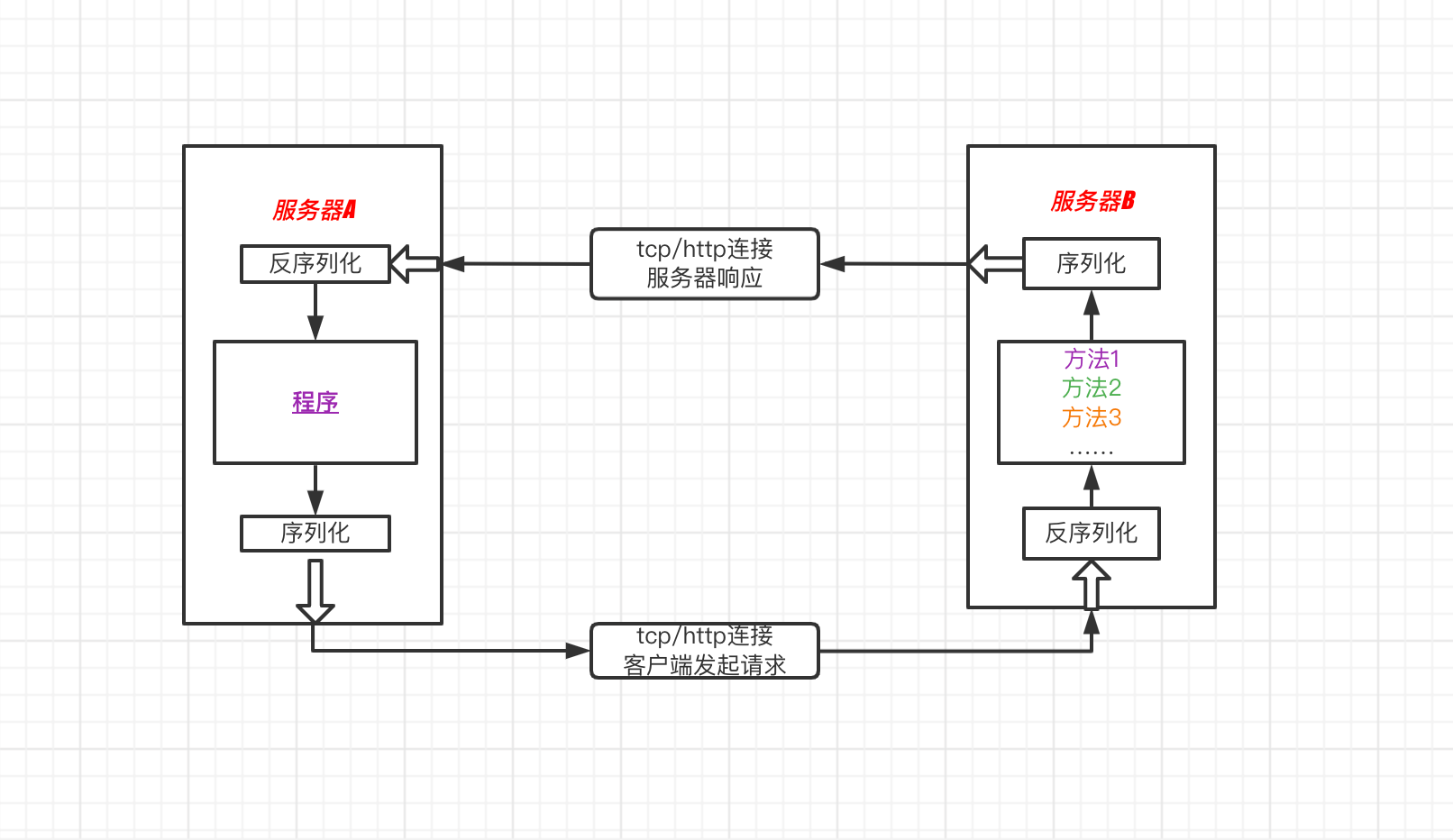
RPC核心概念理解
随机推荐
開期貨,開戶雲安全還是相信期貨公司的軟件?
node中,如何手动实现触发垃圾回收机制
Change Oracle to MySQL
练习:求偶数和、阈值分割和求差( list 对象的两个基础小题)
ClickHouse-表引擎
2.Electron之HelloWorld
Use of five routing guards
[logical fallacy in life] Scarecrow fallacy and inability to refute are not proof
XTask与Kotlin Coroutine的使用对比
基于51单片机红外无线通讯仿真
开期货,开户云安全还是相信期货公司的软件?
Abnormal resolution of Xiaomi camera
Metaprogramming, proxy and reflection
209. Minimum length subarray - sliding window
Use of Shell sort command
Read software engineering at Google (15)
Using quartz under. Net core - calendar of [6] jobs and triggers
Understanding and small examples of unity3d object pool
ASP. Net core configuration options (Part 2)
Oninput one function to control multiple oninputs (take the contents of this input box as parameters) [very practical, very practical]